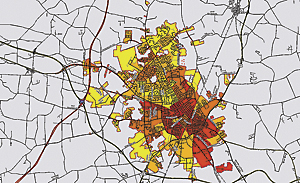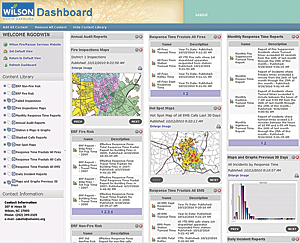Information as a Weapon to Fight Fire
Wilson Fire/Rescue Services Improves Mission Delivery
Highlights
- A GIS-based executive dashboard brings together multiple tabular and geospatial files.
- Mobile data terminals in fire trucks show digital maps and data as soon as personnel enter a truck.
- The county has built an emergency response common operating picture using ArcGIS API for Flex.
Wilson Fire/Rescue Services (WF/RS) of the City of Wilson, North Carolina, serves close to 50,000 people living in an area of roughly 30 square miles. It operates out of five stations. The department offers the full suite of fire services, including first responder emergency medical services (EMS) provided by the closest fire company, a technical-level hazardous materials response team, fire inspection programs, and public education. The services are provided to residential, commercial, industrial, and municipal airport sites.

GIS was used to map the locations of traffic incidents. A hot spot map was created by combining vehicle accident data with street and intersection layers.
The department has an impressive GIS resum�. Since the late 1990s, the agency has used geospatial technology to carry out its mission of preparedness and protection. The city's technology helps move information previously stored in paper binders and file cabinets into an enterprise environment. Whether it is in a vehicle, on the desktop, or on the web, critical data is now accessible at different organizational levels for better decision making. The agency today is recognized throughout the United States as an advanced public safety GIS organization.
"We've been using GIS information for years," says Don Oliver, chief, WF/RS. "With any emergency response, we have just minutes between the alarm sounding and our arrival on scene. Accurate, instantaneous information about the situation improves our chance of success. GIS provides a more accurate situational awareness for our critical decision making."
"Firefighters must be able to rapidly glean, from the vast amounts of data available to them, the critical information needed for a specific event," says Chris Abells, GIS analyst, City of Wilson. "The key for us is to understand what information firefighters need for their decision process and provide accurate information quickly."
Meeting Mission Requirements at Wilson Fire
Today, ArcGIS software, combined with desktop solutions from Esri Partner The Omega Group of San Diego, California, assists in all phases of the WF/RS mission. The city is a long-standing user of Esri software, beginning in the late 1990s.
Emergency planning for hurricanes, floods, and natural disasters begins with ArcGIS Desktop maps. Information is culled from multiple sources. This helps the fire agency access existing plans—like a 100-year floodplain model—that can prove useful in the event of a large emergency. Once a major incident occurs, WF/RS has all the information needed to plan a response, evacuate people, and maintain situational awareness as the event unfolds. Existing plans and maps can be identified for continuous updating.
ArcGIS is used for planning annual building inspections, including vacant commercial buildings. Firefighters must have information such as the building floor plan, the types of materials used in the building construction, the type of sprinkler system in place, and whether there are hazardous materials stored inside.
Staff uses GIS to map out every commercial structure in the city and plan inspections. Fire crews perform preincident surveys and inspections to document vital information useful in an emergency response. In addition, photos are captured to show all outside views and any special considerations inside the structures. The information shows the shape, size, location, and condition of all city buildings, as well as the water supply networks and any built-in fire protection systems that may be utilized during an incident. All this data is then cataloged and stored in GIS. For vacant buildings, the agency rates their conditions and plots their locations. Buildings are put into color-coded categories based on potential danger. Categories of vacant buildings range from structurally sound and secured to abandoned/dangerous. Firefighters can look at individual building plans and maps or macro-level maps showing multiple building locations and their corresponding color category designation.
The data collection for the building preincident surveys has been expanded to identify potential safety considerations regarding rapid collapse potential. Buildings with lightweight construction, engineered structural support features, heavy fire loading, or trussed roof or floor systems are identified and uniquely symbolized in the Rapid Collapse Consideration layer.

Wilson Fire/Rescue Services has a GIS-based executive dashboard that brings together multiple tabular and geospatial files into a single, comprehensive view.
Oliver states, "Being able to access the critical data stored in our GIS immediately provides responding fire officers with the critical information they need to form their strategic plan and employ the appropriate tactics. This ability increases our firefighters' safety by knowing when crews should not enter a structure that is being degraded by fire."
In addition, maps of incidents such as fire, collision, and emergency medical services are brought in from Wilson County's computer-aided dispatch and records management systems and geocoded daily. Maps are generated by week, month, and quarter so that any spike in incidents can be identified and further investigated. Oliver and other staff can determine whether resources—such as fire companies, truck companies, or rescue squads—should be moved from one fire station service district to another location, either permanently or temporarily. Both of these options have been implemented in Wilson by using this data.
For instance, GIS was used to map the locations of traffic incidents. A hot spot map was created by combining fire department vehicle accident data with public services street and intersection GIS layers. When a large number of incidents were shown to be clustered around a specific intersection, it became obvious that action was needed. The city lowered the speed limit for the roadway and reconfigured the intersection, and incidents decreased. The analysis—and integration of data—facilitated the improved safety measures.
WF/RS has a GIS-based executive dashboard from The Omega Group in place that brings together multiple tabular and geospatial files into a single, comprehensive view. It's used for resource allocation and management. Recent events, such as inspections, EMS calls, and fire responses, are viewable in the form of reports, maps, and charts. The information is used by WF/RS senior staff via a simple web browser. Customized analysis routines ensure automatic data updates so that the information presented is always current. Both management personnel and support staff can quickly access and assess the different descriptive reports and maps for strategic planning purposes.
For tactical daily use, mobile data terminals located in fire trucks show digital maps and data as soon as personnel enter a truck to respond to an emergency. Digital street maps show the exact location of the incident. Maps and related tabular information help firefighters see aerial photos, possible hazardous materials, hydrant locations, electric lines, water supplies, and more. Personnel can quickly ascertain the situation and incident potential as they are arriving on scene.
In addition, Wilson County has built an emergency response common operating picture (COP) using ArcGIS API for Flex. This provides real-time data views and analysis during large-scale incidents. As part of the COP, the county is supporting a national geospatial grid. This grid provides a common set of georeferenced location points that are uniform across the United States.
Taking Advantage of Existing City Resources
WF/RS works closely with Abells, who is assigned to the fire department three days a week. The cooperation yields significant results. An enterprise Esri system was already in place at the city when WF/RS first began using ArcGIS. The fire department immediately began using information housed by other departments. Spatial data included streets, water lines and hydrants, electrical and gas lines, and building and zoning specifications. WF/RS combines these datasets with its own data, including fire stations, apparatus locations, service area boundaries, and types of incidents. Abells coordinates with the multiple city departments to ensure that each one can easily provide its data and access data from other departments. Perhaps no other city sector requires this valuable data—from nearly every city department—like WF/RS.
"We have to worry about all of it," explains Oliver. "We need to reach out and touch everything."
The city fire department has been a beacon for how technology can make a difference protecting communities. Oliver and his staff have presented at numerous conferences—including the Fire Department Instructors Conference, Fire Rescue International, and the Esri International User Conference. He's also traveled to fire departments across the country.
"GIS technology is making a significant difference in our industry," he says. "It's being used now more than ever for critical decision making. It is exciting and encouraging that our profession is creating a safer environment for our firefighters and citizens."
For more information, contact Chief Don Oliver, WF/RS (e-mail: doliver@wilsonnc.org).